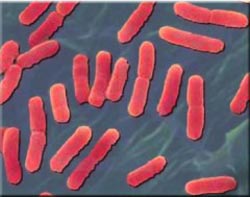Rochester Scientists Develop Fast-Working Biosensor

University of Rochester Medical Center scientists have demonstrated a new technology that accurately and rapidly detects the meat-spoiling and sometimes dangerous E. coli bacteria.
The unique technology uses a protein from the suspect bacteria as part of the sensing system that also includes a silicon chip and a digital camera.
The journal Biosensors and Bioelectronics published an article on the technology in its February issue. Benjamin Miller, Ph.D., an associate professor of dermatology at the Medical Center, is the lead author of the article.
“We’ve developed a very inexpensive technology that can detect an infectious agent,” said Miller, who is part of the university’s Center for Future Health “It’s clearly faster and cheaper than any competing technology. This is another step on the way to point-of-care diagnostics.”
The technology potentially could detect any biological entity, Miller said. A physician someday, for example, could use the technology in his office to confirm a streptococcal infection in a patient with a sore throat.
The Rochester research team calls the technology “arrayed imaging reflectometry.” The system utilizes a silicon chip that is made so that laser light reflected off the chip is invisible unless the target bacteria are present.
The target described in the Biosensors and Bioelectronics article is the bacteria Escherichia coli.
A protein from the bacteria, Translocated Intimin Receptor or Tir, is placed on the chip. The Tir can be seen as a “molecular harpoon,” Miller said. The E. coli sends out the harpoon into a cell. Once it is in the cell, the Tir then binds with an E. coli protein called Intimin. A similar process occurs between the Tir placed on the chip and any E. coli in the sample being tested. The binding of the probe and the bacteria alters the surface of the chip. A digital camera image of the chip captures the changes for analysis and confirmation of detection.
Traditional methods of detection of bacteria can take days. “This takes as much time as it takes for a snapshot,” Miller said.
The scientists currently are defining the sensitivity levels of the technology, previously called reflective interferometry, and extending the system to other biological targets.
In addition to Miller, the authors of the journal article include Lewis J. Rothberg, professor of chemistry and member of the Center for Future Health, Scott R. Horner, who earned a doctorate in biophysics at the University of Rochester, and Charles R. Mace, a University of Rochester doctoral student in biophysics.
Pathologics, a Rochester area start-up company, was launched to further develop and commercialize the technology. Miller, Rothberg and Horner have a financial interest in the company. Horner is chief technical officer at Pathologics.
Research for the work was supported by grants from the U.S. Department of Energy and the National Institutes of Health.
For more media inquiries, contact:
Michael Wentzel
(585) 275-1309
michael_wentzel@urmc.rochester.edu
Media Contact
More Information:
http://www.urmc.rochester.eduAll latest news from the category: Life Sciences and Chemistry
Articles and reports from the Life Sciences and chemistry area deal with applied and basic research into modern biology, chemistry and human medicine.
Valuable information can be found on a range of life sciences fields including bacteriology, biochemistry, bionics, bioinformatics, biophysics, biotechnology, genetics, geobotany, human biology, marine biology, microbiology, molecular biology, cellular biology, zoology, bioinorganic chemistry, microchemistry and environmental chemistry.
Newest articles

Silicon Carbide Innovation Alliance to drive industrial-scale semiconductor work
Known for its ability to withstand extreme environments and high voltages, silicon carbide (SiC) is a semiconducting material made up of silicon and carbon atoms arranged into crystals that is…

New SPECT/CT technique shows impressive biomarker identification
…offers increased access for prostate cancer patients. A novel SPECT/CT acquisition method can accurately detect radiopharmaceutical biodistribution in a convenient manner for prostate cancer patients, opening the door for more…

How 3D printers can give robots a soft touch
Soft skin coverings and touch sensors have emerged as a promising feature for robots that are both safer and more intuitive for human interaction, but they are expensive and difficult…





















